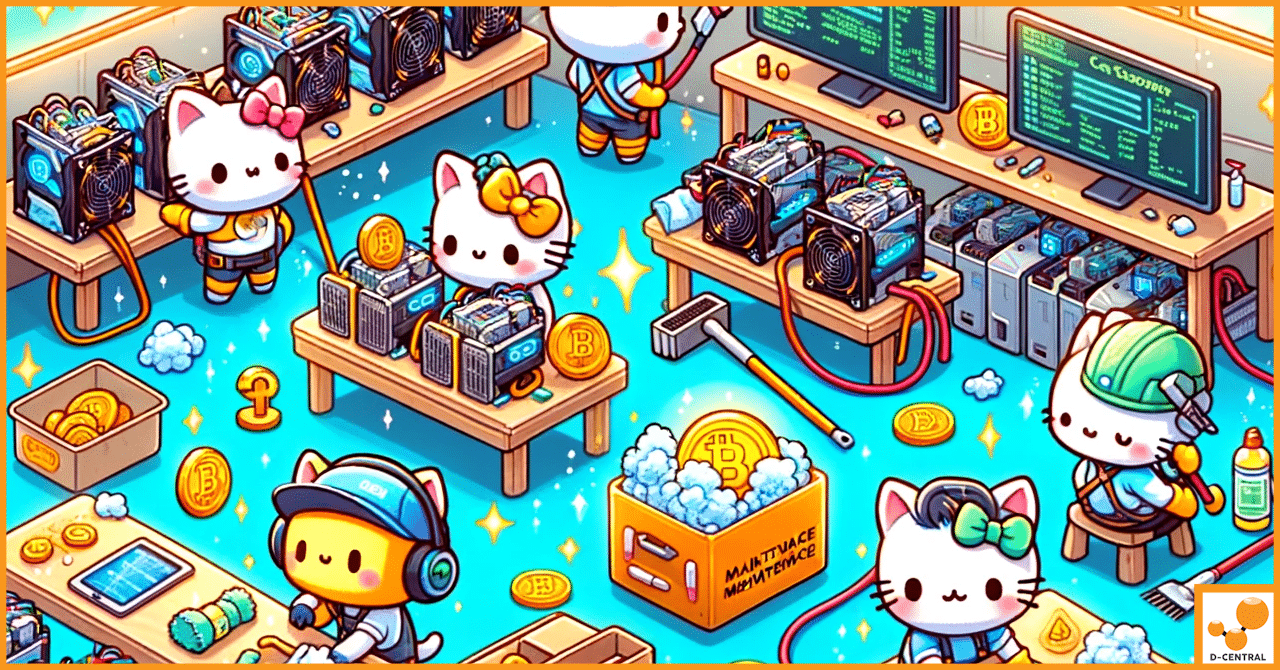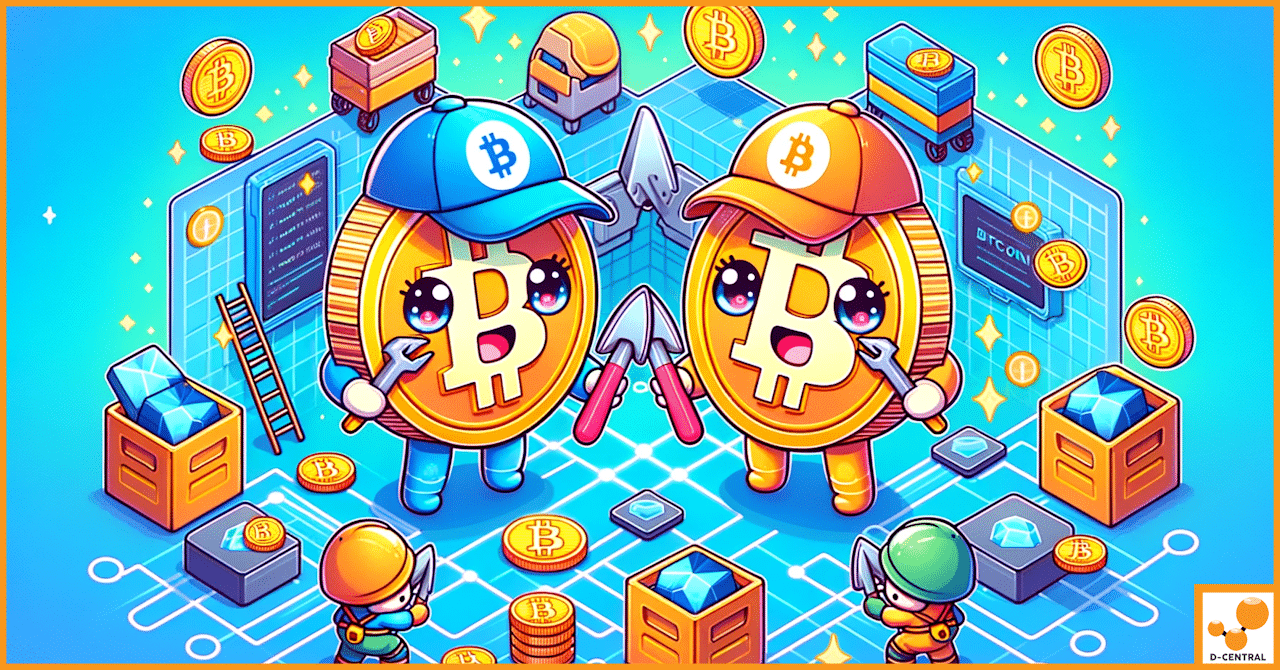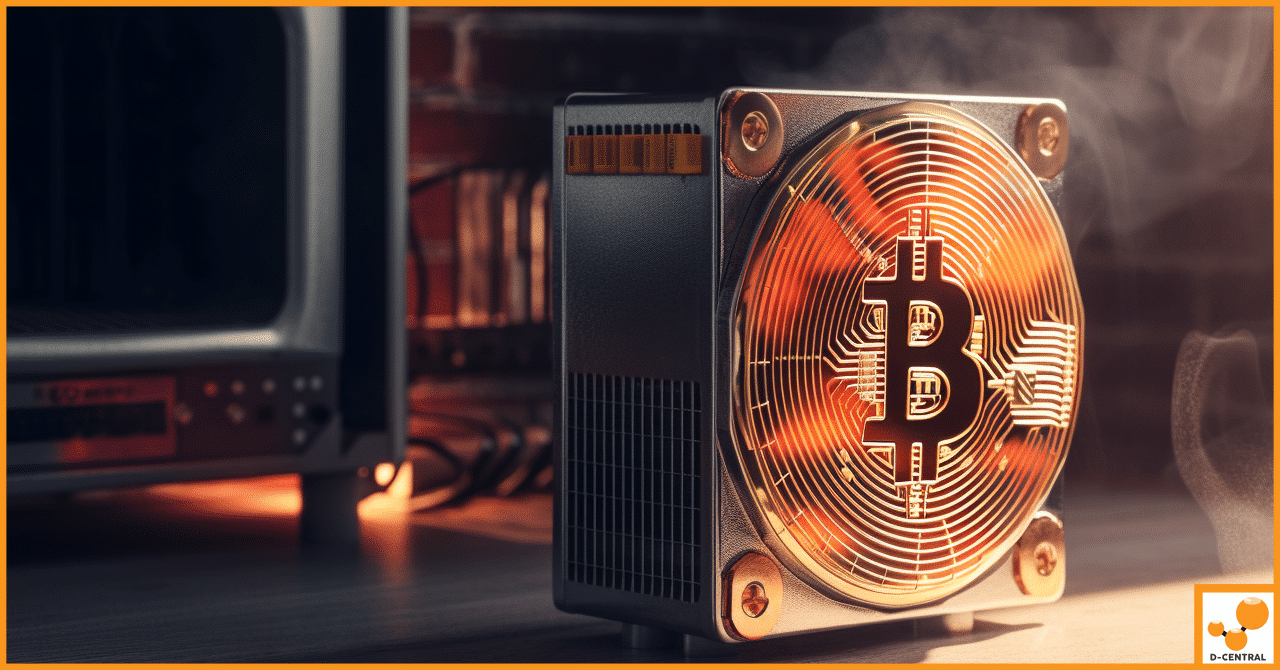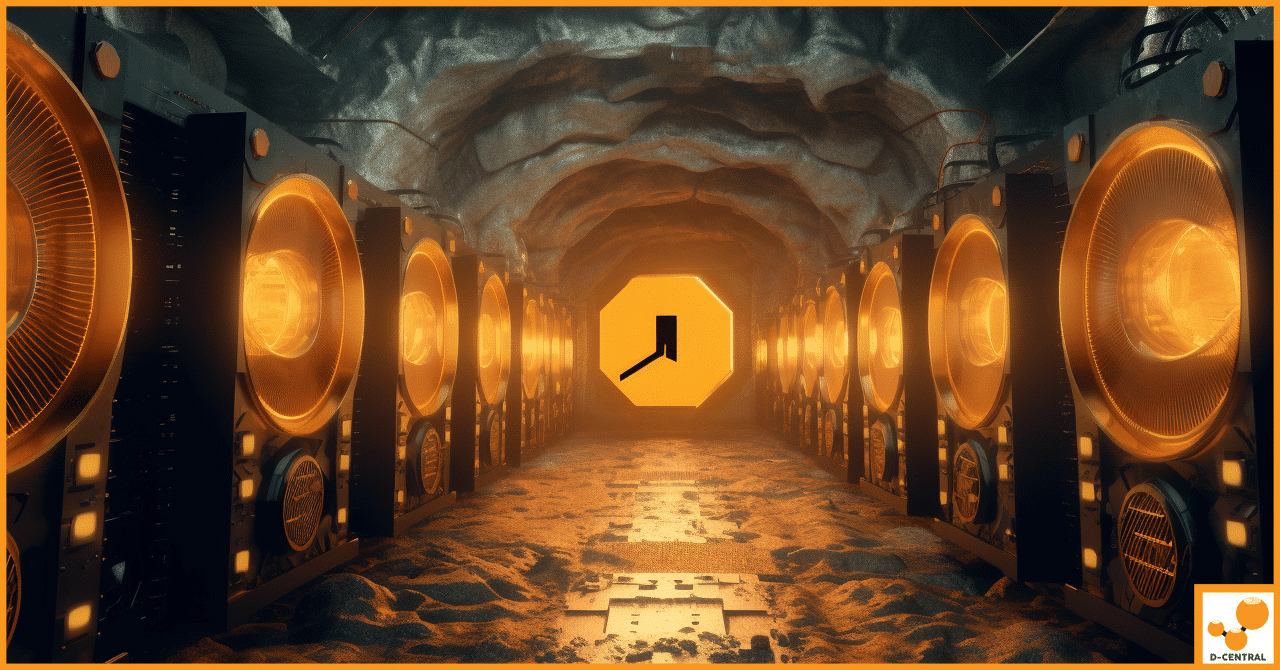
The Ultimate Guide to Maintaining and Cleaning Your Bitcoin ASIC Miners
In the dynamic world of cryptocurrency mining, maintaining optimal operation of Application-Specific Integrated Circuit (ASIC) miners is not just a
4479 Desserte Nord Autoroute 440, Laval, QC H7P 6E2

In the ever-evolving world of cryptocurrency, the security of the Bitcoin blockchain stands as a paramount concern, intricately woven into the fabric of digital currency transactions. This security is not a product of chance but the result of a meticulously designed system of checks and balances, upheld by the harmonious interplay of nodes and miners within the blockchain network. At the heart of this robust security mechanism lies the unique and critical roles played by both these entities, each contributing indispensably to the integrity and resilience of the Bitcoin ecosystem.
D-Central Technologies, a vanguard in the Bitcoin mining industry, understands the significance of this balance deeply. As Canada’s premier ASIC repair center and a leader in providing comprehensive Bitcoin mining solutions, D-Central Technologies is more than just a participant in this space. We are innovators and educators, committed to enhancing the understanding and implementation of blockchain technology. Our expertise not only lies in offering top-tier mining and repair services but also in fostering a deeper comprehension of how the Bitcoin blockchain maintains its security and reliability, ensuring the trust and efficiency that users worldwide have come to expect.
In this exploration, we delve into the intricate dance between nodes and miners, unravelling how their combined efforts create a fortress of security that is both dynamic and robust, safeguarding the Bitcoin blockchain against vulnerabilities and ensuring its position as the epitome of digital currency reliability.
In the intricate world of Bitcoin, the security and efficiency of its blockchain are upheld by a critical, yet often misunderstood, partnership between nodes and miners. This relationship is not merely cooperative but symbiotic, with each playing a distinct and vital role in maintaining the network’s integrity and functionality.
At one end of this spectrum are the nodes, the vigilant gatekeepers of the Bitcoin blockchain. Nodes are essentially computers connected to the Bitcoin network, which perform the crucial task of verifying transactions and blocks against the network’s consensus rules. These rules are the bedrock of Bitcoin’s protocol, dictating the validity of transactions and ensuring that each transaction adheres to the network’s agreed-upon standards.
Every transaction on the Bitcoin network is broadcast to these nodes, which scrutinize them for adherence to the rules. This includes checks for double-spending, ensuring that the same Bitcoin is not spent more than once, and verifying that each transaction is properly signed by the sender. Nodes also validate the creation of new Bitcoins, ensuring that miners adhere to the constraints of Bitcoin’s supply schedule.
On the other side are the miners, the architects who construct the edifice of the blockchain. Miners perform the labor-intensive task of adding new transactions to the blockchain. This process begins with miners collecting a set of unconfirmed transactions from the pool of transactions broadcasted by the network. They then apply a complex cryptographic process known as proof-of-work to these transactions, competing to solve a mathematical puzzle that requires significant computational resources.
The first miner to solve the puzzle gets the privilege of adding a new block of transactions to the blockchain. This block, once added, is broadcast to the nodes for verification. It’s crucial to note that miners are also nodes and perform an initial verification of transactions before attempting to add them to a block. This dual role enhances the network’s security, as miners have a vested interest in maintaining the network’s integrity to receive the block reward and transaction fees.
The true beauty of Bitcoin’s security model lies in the delicate balance of power between nodes and miners. While miners are responsible for adding new blocks to the blockchain, it is the nodes that have the final say in accepting these blocks. If a miner attempts to add a block that violates the consensus rules, nodes will reject this block, effectively nullifying the miner’s efforts and the resources expended in the mining process.
This balance ensures that no single entity can unilaterally alter the blockchain or manipulate the system for personal gain. Miners are incentivized to follow the rules set by the consensus to get their block rewards, while nodes continuously monitor and enforce these rules, maintaining the sanctity and reliability of the blockchain.
In conclusion, the symbiotic relationship between nodes and miners is a testament to the ingenious design of the Bitcoin network. It’s a system where collaboration and competition coexist, each entity reinforcing the other, culminating in a blockchain that is remarkably secure, transparent, and resilient. At D-Central Technologies, we recognize and celebrate this intricate dance, as it forms the foundation upon which we build our services and solutions, contributing to the ever-growing and evolving world of Bitcoin.
The Bitcoin blockchain, a marvel of modern technology, owes much of its resilience and integrity to the unsung heroes of the network: the nodes. These crucial components serve as the backbone of blockchain security, playing a pivotal role in transaction verification and the enforcement of the network’s consensus rules. Understanding the depth of their function provides insight into the sophisticated architecture of Bitcoin’s security model.
Nodes, in their essence, are individual computers connected to the Bitcoin network, each hosting a complete copy of the entire blockchain. This decentralized network of nodes is responsible for verifying every transaction that occurs within the system. When a transaction is broadcasted to the network, nodes independently verify its validity. This process includes several checks:
Beyond transaction verification, nodes are instrumental in maintaining the overall integrity of the blockchain. They store and continually update a complete history of all transactions, ensuring transparency and immutability — two core tenets of blockchain technology. This comprehensive ledger is what makes the Bitcoin network a ‘trustless’ system; the truth of transaction history does not rely on a single entity but is instead distributed across the entire network of nodes.
The role of nodes extends to a critical balancing act in the Bitcoin ecosystem — keeping miners in check. Miners, driven by the incentive of earning Bitcoins, add new blocks of transactions to the blockchain. However, it is the nodes that have the ultimate authority to accept or reject these blocks. If a miner attempts to add a block that violates the consensus rules — such as including invalid transactions or tampering with the block reward — nodes will reject this block. This rejection not only nullifies the miner’s effort but also serves as a deterrent against any malicious attempts to alter the blockchain.
This system of checks and balances is fundamental to the decentralized nature of Bitcoin. Nodes, by enforcing the consensus rules, ensure that no single miner or group of miners can monopolize or corrupt the network. They act as the guardians of the protocol, maintaining the democratic ethos upon which Bitcoin was built.
In summary, nodes are the steadfast sentinels of the Bitcoin blockchain, ensuring every transaction is valid and every block adheres to the network’s stringent rules. Their role in transaction verification and enforcing consensus rules is paramount to the security and integrity of the blockchain. At D-Central Technologies, we recognize and underscore the importance of nodes in our blockchain solutions, ensuring that our services not only leverage but also contribute to the robust security framework of the Bitcoin network. Through our efforts, we aim to uphold and enhance the trust and reliability that are the hallmarks of blockchain technology.
In the dynamic world of Bitcoin, miners play a pivotal role, acting as the driving force behind the continuous growth and progression of the blockchain. Their role extends far beyond mere transaction processing; miners are the architects of blockchain advancement, contributing significantly to both its security and its forward momentum.
Miners are the participants in the Bitcoin network responsible for creating new blocks, a process that lies at the heart of blockchain technology. This task involves collecting and bundling together a set of pending transactions from the network’s transaction pool. However, adding these transactions to the blockchain isn’t as straightforward as it might seem. It requires the successful completion of a process known as proof-of-work (PoW).
Proof-of-work is a cryptographic puzzle that demands significant computational power to solve. Miners compete to find the solution to this puzzle, and the first miner to do so earns the right to add the new block of transactions to the blockchain. This process is not only computationally intensive but also time-consuming, ensuring that new blocks are added at a consistent rate, which is crucial for the network’s stability.
Before miners even begin the process of solving the PoW puzzle, they perform an initial verification of each transaction in the block. This step is crucial as it ensures that all transactions comply with the Bitcoin protocol. Miners check for the validity of each transaction, ensuring that the inputs and outputs are correct, the digital signatures are valid, and the transactions have not been previously spent.
This initial verification by miners serves as the first line of defense against fraudulent or invalid transactions. It is a critical component of the network’s security, as it prevents the blockchain from being cluttered with invalid data, which could potentially compromise its integrity.
The role of miners is integral to both the security and the forward movement of the blockchain. By solving the PoW puzzle, miners not only add new transactions to the blockchain but also help to secure it. Each new block added to the chain is a confirmation of the previous blocks, making it exponentially harder to alter past transactions as the blockchain grows. This aspect of the mining process is what gives Bitcoin its characteristic immutability.
Furthermore, miners contribute to the decentralization of the Bitcoin network. The distributed nature of mining operations around the world means that no single entity has complete control over the blockchain. This decentralization is a key factor in the security and resilience of the Bitcoin network.
Miners, with their dual role of transaction verifiers and block creators, are indeed the backbone of the Bitcoin blockchain. Their efforts not only ensure the addition of new transactions but also fortify the network against potential threats. At D-Central Technologies, we recognize the indispensable role of miners in the blockchain ecosystem. Our services and solutions are designed to support and enhance the efficiency and effectiveness of mining operations, contributing to the ongoing strength and progression of the Bitcoin blockchain.
The Bitcoin ecosystem operates on a delicate balance between two of its most fundamental components: nodes and miners. This equilibrium is not just a feature of the system; it is the very essence of its security and decentralization. Understanding how this balance is maintained is key to appreciating the ingenuity and resilience of the Bitcoin blockchain.
The relationship between nodes and miners in the Bitcoin network is one of interdependence and mutual checks. While miners are responsible for creating new blocks and adding them to the blockchain, nodes are tasked with validating these blocks and ensuring they adhere to the network’s consensus rules. This dynamic creates a system where each party holds the other accountable, ensuring the integrity of the blockchain.
Miners, incentivized by block rewards and transaction fees, are motivated to add as many blocks as they can. However, their ability to do so is constrained by the nodes, which validate the transactions within these blocks. If a miner attempts to include invalid transactions or deviates from the network’s rules, nodes will reject the block, rendering the miner’s efforts and expended computational resources futile.
This balance is also crucial in maintaining the decentralized nature of the Bitcoin network. Decentralization is a core principle of Bitcoin, preventing any single entity from gaining control over the blockchain. Nodes, distributed globally and operated by various individuals and entities, ensure that the network remains decentralized. They validate transactions and blocks independently, ensuring that no single miner or group of miners can dominate the blockchain.
Miners, spread across different geographies and operating under varying scales, further contribute to this decentralization. The competitive nature of mining, where different miners vie to add the next block, ensures that no single miner can monopolize the blockchain creation process. This competition is vital for the health and security of the network.
The Bitcoin network is designed to align the interests of both miners and nodes. Miners are driven by the rewards they receive for adding new blocks, but they can only obtain these rewards if the nodes accept their blocks. This creates a system where miners are incentivized to follow the rules set out by the network. Similarly, nodes, while not directly financially incentivized, are motivated by the desire to maintain a secure and trustworthy network, as this increases the value and utility of Bitcoin.
The balance between nodes and miners in the Bitcoin ecosystem is a masterful design of checks and balances. It ensures that all interests are kept in check, and the network remains secure and decentralized. This equilibrium is not static but a dynamic interplay that adapts and evolves with the network. At D-Central Technologies, we understand the importance of this balance and strive to support it through our services and solutions, contributing to the ongoing strength and stability of the Bitcoin blockchain.
The theoretical balance between nodes and miners in the Bitcoin ecosystem is not just an abstract concept; it has tangible, real-world implications that play out in various scenarios. These examples not only illustrate the effectiveness of this balance but also highlight the network’s ability to address and overcome potential challenges.
One of the most common threats in any digital currency system is double spending, where an entity attempts to spend the same digital token twice. In the Bitcoin network, this is mitigated by the interplay between nodes and miners. When a miner includes a transaction in a block, nodes across the network independently verify that the bitcoins haven’t been previously spent. If a miner tries to include a double-spent transaction, nodes will reject the block, preventing the fraudulent transaction from being recorded on the blockchain.
Occasionally, the Bitcoin network may experience forks, where the blockchain diverges into two potential paths. This can happen when miners disagree on certain upgrades or changes to the protocol. Nodes play a crucial role in these situations. They choose which version of the blockchain to accept by validating transactions according to the consensus rules they support. This decentralized decision-making process ensures that the network follows the version of the blockchain supported by the majority, maintaining network integrity and user trust.
The risk of centralization, particularly through large mining pools gaining disproportionate control over the block creation process, is a concern in the Bitcoin network. However, the balance between nodes and miners addresses this. Even if a mining pool controls a significant portion of the network’s hash rate, it cannot unilaterally alter the blockchain without node approval. Nodes ensure that all blocks adhere to the network’s consensus rules, regardless of who mines them, preventing any single miner or pool from dictating changes to the blockchain.
The Bitcoin network is designed to be self-regulating and resilient to various challenges:
The real-world scenarios in which the balance between nodes and miners plays out demonstrate the robustness and adaptability of the Bitcoin network. This balance is crucial in addressing potential challenges, ensuring the network remains secure, decentralized, and aligned with the collective interests of its users. At D-Central Technologies, we recognize the importance of these dynamics and are committed to supporting the ongoing health and resilience of the Bitcoin ecosystem through our services and expertise.
The security and robustness of the Bitcoin blockchain are not the products of a singular entity or process but are the result of the harmonious and cooperative efforts of both nodes and miners. This intricate dance between these two pivotal components forms the bedrock of the network’s integrity and trustworthiness.
Nodes, serving as the vigilant auditors of the network, ensure that every transaction adheres to the established consensus rules, maintaining the blockchain’s integrity and trust. They act as the decentralized guardians, preventing fraudulent activities like double-spending and ensuring that the history of transactions remains immutable and transparent.
Miners, on the other hand, are the dynamic force driving the blockchain forward. Through their intensive computational efforts in solving cryptographic puzzles, they add new blocks of transactions to the blockchain. This not only facilitates the processing of transactions but also fortifies the network’s security by validating and recording these transactions in a tamper-resistant manner.
The true strength of the Bitcoin blockchain lies in the synergy between nodes and miners. Each plays a distinct yet interdependent role, creating a system where checks and balances are inherently built-in. This synergy ensures that the network remains secure, decentralized, and resilient against various threats and challenges.
The security of the Bitcoin blockchain is a testament to the collective efforts of nodes and miners, each playing a crucial role in its functionality and security. At D-Central Technologies, we are proud to be part of this ecosystem, providing expertise and services that support and enhance the Bitcoin network. Join us in exploring and contributing to this revolutionary technology that is reshaping the world of finance and digital transactions.
What roles do nodes and miners play in the Bitcoin blockchain?
Nodes serve as gatekeepers, verifying transactions and ensuring they adhere to Bitcoin’s consensus rules, maintaining the blockchain’s integrity. Miners add new transactions to the blockchain through a process called proof-of-work, driving its growth and securing its data.
How does D-Central Technologies contribute to the Bitcoin mining industry?
D-Central Technologies is a leader in providing comprehensive Bitcoin mining solutions, including ASIC repair services, educating on blockchain security and reliability, and enhancing the implementation of blockchain technology. They play a pivotal role in supporting the Bitcoin mining community.
What is the relationship between nodes and miners in the Bitcoin network?
The relationship between nodes and miners is symbiotic and involves mutual checks and balances. Miners create new blocks, while nodes validate these blocks against the consensus rules. This dynamic ensures the network’s integrity and decentralization.
Why is decentralization important in the Bitcoin network?
Decentralization prevents any single entity from gaining control over the network, ensuring that it remains secure and operates on a trustless system. It contributes to the network’s resilience against attacks and attempts at manipulation.
What real-world scenarios demonstrate the balance between nodes and miners?
Real-world scenarios include preventing double spending, resolving forks and consensus disputes, and curbing centralization attempts by large mining pools. The balance between nodes and miners ensures the network’s integrity and adaptability to challenges.
How does D-Central Technologies support the Bitcoin ecosystem?
D-Central Technologies supports the Bitcoin ecosystem through their services that focus on enhancing the efficiency and security of mining operations, contributing to the network’s strength and promoting the growth and understanding of blockchain technology.
DISCLAIMER: D-Central Technologies and its associated content, including this blog, do not serve as financial advisors or official investment advisors. The insights and opinions shared here or by any guests featured in our content are provided purely for informational and educational purposes. Such communications should not be interpreted as financial, investment, legal, tax, or any form of specific advice. We are committed to advancing the knowledge and understanding of Bitcoin and its potential impact on society. However, we urge our community to proceed with caution and informed judgment in all related endeavors.
Related Posts

In the dynamic world of cryptocurrency mining, maintaining optimal operation of Application-Specific Integrated Circuit (ASIC) miners is not just a

Bitcoin mining is an energy-intensive process that generates immense amounts of heat. But instead of being wasted, this excess heat

In the realm of digital finance, Bitcoin, the premier cryptocurrency, has taken a commanding lead. The mining of this digital